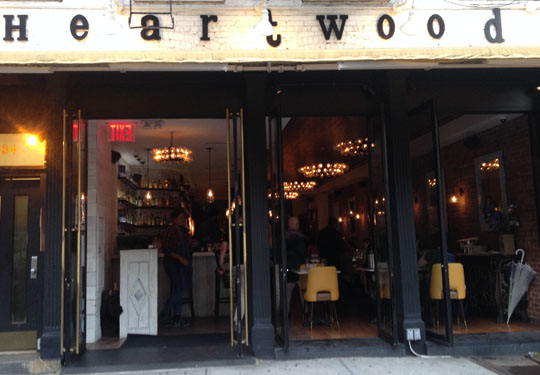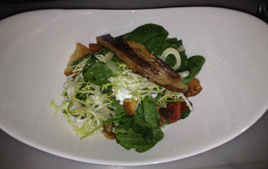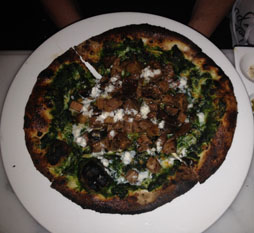Blenheim
 Monday, August 18, 2014 at 08:00PM
Monday, August 18, 2014 at 08:00PM 
Note: Chef Ryan Tate left Blenheim abruptly in March 2015. Mazen Mustafa is the restaurant’s third chef in its first year of existence.
*
 When a restaurant announces that it’s “closing temporarily,” it’s usually done-for. So I promptly crossed Blenheim off my to-do list when opening chef Justin Hilbert was canned, and the restaurant shuttered, after a month in business.
When a restaurant announces that it’s “closing temporarily,” it’s usually done-for. So I promptly crossed Blenheim off my to-do list when opening chef Justin Hilbert was canned, and the restaurant shuttered, after a month in business.
Blenheim escaped the usual fate of such establishments—and recovered brilliantly, in fact—when Tribeca’s Le Restaurant closed, and the Michelin-starred chef Ryan Tate became a free agent. A couple of weeks later, Tate was in, and Blenheim had recovered from the dead. Full disclosure: I wasn’t a fan of Le Restaurant. I must’ve caught it on a bad day, as no one else disliked it as much as I did. The food at Blenheim is terrific.
 The owners are husband-and-wife team Min Ye and Morten Sohlberg, best known for the Smörgås Chef mini-chain of Swedish restaurants. In 2007, they bought the Blenheim Hill Farm in the Catskill Mountains, which dates back to the 1700s, but had been abandoned since the 1970s. They restored the farm, and started raising pesticide-free produce and heritage breeds of pigs, cattle, and lamb.
The owners are husband-and-wife team Min Ye and Morten Sohlberg, best known for the Smörgås Chef mini-chain of Swedish restaurants. In 2007, they bought the Blenheim Hill Farm in the Catskill Mountains, which dates back to the 1700s, but had been abandoned since the 1970s. They restored the farm, and started raising pesticide-free produce and heritage breeds of pigs, cattle, and lamb.
You might’ve guessed that a farm-to-table restaurant wouldn’t be far behind. Welcome to Blenheim, which will remind you of that other restaurant with an affiliated farm, Blue Hill, in its humbler days, before it started serving S. Pellegrino cuisine and playing host to presidents. (Even Smörgås Chef now touts its farm-to-table bona fides, which wasn’t the case when we visited in 2007.)
 The v1.0 release of Blenheim had no online menu, but The Pink Pig sampled a Guinea Hen dish that was $32; the same is now $27. Further comparisons aren’t possible, but I gather the new chef has thoroughly re-habilitated the menu, which is now firmly mid-priced, with appetizers $10–19 and entrees $20–34. There are no snacks or side dishes to plump up the bill.
The v1.0 release of Blenheim had no online menu, but The Pink Pig sampled a Guinea Hen dish that was $32; the same is now $27. Further comparisons aren’t possible, but I gather the new chef has thoroughly re-habilitated the menu, which is now firmly mid-priced, with appetizers $10–19 and entrees $20–34. There are no snacks or side dishes to plump up the bill.
There are also two so-called tasting menus: four courses ($65) and seven courses ($95). Wine pairings are $35 and $55 respectively. We chose the former. If I’m picky, the four-course option isn’t really a tasting menu, although it did come with a couple of amuses. The wine pairing came with four pours, and at the price would have to be called generous.
The amuse (above left) was a tomato carpaccio with lovage emulsion, about as perfect as tomatoes can be. The bread service (above right) offered a choice of three varieties, served warm, with soft butter from the farm.


Blenheim 1.0 was criticized for serving “overly precious creation[s] made mostly from greens that humans don’t typically eat for a reason.” You see it, too, in The Pink Pig’s far more favorable review.
There’s still some evidence of that at Blenheim 2.0 (a $15 gin and lime cocktail served with ice plant) and on the plates above, where farm greenery is tossed about, mainly because they can. Le Restaurant, the chef’s last place, suffered from similar self-indulgence, but here the dishes succeed.
We started with White Asparagus (above left), not from the local farm, but from northern Italy, with a poached egg, sorrell, and pine juice. “Mix it up and have fun,” the server exhorted, in case you were wondering. There was a crunchy, crouton-like ingredient, and something sweet I couldn’t identify. The chef had done something incredible with very little.
Greenery on the next plate was purely decorative, but the Skate Wing (above right) was exquisite.


Pork Loin (above left) had a pungent, “hammy” taste that was wonderful. I also enjoyed the salted peaches on the plate, but didn’t need charred okra or smoked onion.
The dessert amuse was a cucumber sorbet, tasting something like a key lime pie, which I didn’t photograph. The dessert was a cream cheese panna cotta (above right) with plums, whey, and buckwheat crêpes that was one of the best desserts I’ve had in a while.
The ambiance at Blenheim straddles the line between high-end informal and low-end formal. Despite the tablecloth-free décor of exposed wood and farm implements hung from the walls, the dining room feels upscale: it’s a third-date place. The staff are extremely attentive about the small things, such as the setting and clearing of plates and silverware. There are butter knives on the tables, and when was the last time you saw that outside of a three-star restaurant.
The dining room was quiet, and only about half full at 8:00pm; by 10:00 it was almost empty. There is nothing wrong with the location, an ideal West Village street corner, in a part of town where many restaurants have thrived. Blenheim has got the chef; now it just needs the buzz.
Blenheim (283 W. 12th Street at W. 4th Street, West Village)
Food: Haute barnyard
Service: Upscale
Ambiance: Straddling high-end informal and low-end formal
Rating: ★★




































